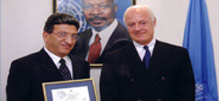Solar Impulse: Shift Gear, Drop Weight, Change Altitude
Najib Saab
July 2013
Ten weeks after its departure from San Francisco, on the West Coast of the United States, Solar Impulse landed in New York on the East Coast. During many stopovers between the kickoff and final destination, cities were awarded green certificates for supporting eco-friendly technology, and millions visited the plane to have closer look on solar power in action. Earlier in 2012, Solar Impulse initiated its first intercontinental flight, between Spain and Morocco. Although this was not the first long journey for the Swiss explorer Bertrand Piccard in his solar-powered plane, the USA journey was significant in a country deeply divided on energy options.
Skeptics may not see an achievement in a one-passenger plane taking 70 days to cover 5,000 kilometers. However, that adventure may pave the way for a new era of renewable energy. The aircraft was totally powered by energy coming from 10,000 photovoltaic solar cells covering its wide wings. Although the width of each wing is bigger than that of a jumbo jet, Solar Impulse weighs less than 1600 kilograms, less than the weight of some midsize family cars, thanks to light carbon fiber material especially developed to build its body. The plane could maintain a full 24-hour flight, night and day, using power stored in custom-made batteries. Such achievement was the result of cooperation among dozens of European research centers and companies that supported the project.
The Solar Impulse American flight was particularly significant in that it has given momentum for the solar power drive in a country divided between pro-renewables and skeptics. The public generally support the notion of generating power from clean and renewable sources, yet most do not have the patience to wait for seeing the results.
Research, development and experiments to reach cost-effective solutions that can be used on a large scale need long time. But Piccard was able to stir up the curiosity of Americans. He made them see, with their own eyes, that what had been considered an unattainable dream became close at hand. US Secretary of Energy, Ernest Moniz, expressed this very clearly after the plane landed in Washington D.C., saying that the flight highlighted a cleaner energy future for America. He noted that the technologies used in his solar plane, specifically photovoltaic cells, lightweight materials, and highly-efficient batteries, may be used for making cleaner devices, greener cars, more energy-efficient building, and various appliances for everyday use. With his high-profile adventure, Piccard brought solar energy to the perception of common people.
The plane used for the American flight was just a prototype of a second generation currently being developed by the Solar Impulse team, and is scheduled to fly around the world in 2015. By then, photovoltaic cells would be more efficient, the materials for building the body would be stronger and lighter, and the life of batteries longer.
Change can only be attained by pioneers who stand up to challenges and look for a better future. Bertrand Piccard is definitely one of those pioneers. Before the solar plane, Piccard accomplished in 1999 a non-stop balloon flight around the globe. His grandfather, the physicist and inventor Auguste Piccard, had designed in 1932 a special cabin for balloon flights that allowed him to ascend to 17,000 meters, thus increasing flight speeds, which marked an unprecedented development in the history of aviation. When I met Bertrand a few months ago at Desertec convention in Berlin, he told me that the bold vision of his grandfather had been his main source of inspiration. The prime lesson learnt was that rather than wasting time in trying to affect change by continuing to use the same old methods with cosmetic adjustments, think outside the box: shift gear, drop weight, fly at different altitude.
I remembered Piccard words while recently listening to skeptics at an energy conference in one oil exporting country, who insisted that solar and wind energy are not reliable due to high cost of storage. Those need an Auguste Piccard, who would advise them to change gear and fly freely. While a solar plane would need a sophisticated battery to store energy, solar-powered pumps, for instance, can work all day long to generate electricity and pump water to tanks on elevated areas. At night, hydroelectricity is generated by turbines run by the gravitational force of falling water. Solar electricity can also be utilized during the day to produce hydrogen from seawater. Hydrogen can then be used at any time, day or night, for power generation. Needless to mention that hydrogen is a clean power carrier that leaves only drops of water after uniting again with oxygen to produce power. As the world will need all available sources of energy, but in cleaner ways, human ingenuity shall also develop an effective and safe technology for capturing and storing carbon emissions from burning fossil fuels. The sky becomes the limit when you learn to get out of the box.
Thank you, Bertrand Picard.You have proved to the world that the future starts now.
|




